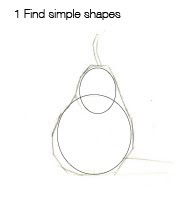One of the key elements of drawing from life is finding the underling structure of the subject your are drawing. This means looking for the basic shapes first, then finding the surface planes and changes. Then refine those shapes to match what you see.
 |
| Reference for drawing. |
Today, I thought I'd use a pear as an example to use to look for an object's structure, because it simple enough yet has enough complexity to require us to look. Though, for this exercise any fruit will do. I simply like the pear because it is not just a round object, like an orange or even an apple. The shape gives us more to search for and analyse. Though you are more then welcome to use any object you like.
Here I set up a pear against a dark background with a single light source, just to make things easy. The more light sources you have the harder it is to determine the plane changes and the surface direction. (It also make it easier to figure out the value pattern, but that is for another time)

Find the Simple Shapes
The first thing to look for is the simplest shapes you can see in the subject. In this case a pear can be seen as a couple of circles or ellipses. You don't need to draw the ellipses just look for the shapes to guide you.
Capture the Outlining Edges
Once you have found the simple shapes draw the outlining edges of shape of the subject. Use straight lines to keep shape clearly defined. We can always refine the rounded edges later.
Find the Planes and Plane Changes
Once have the general shape. You want to start looking at the volume of the subject. The volume is just the form in three dimensions. To find the volume there are several approaches. The method we will use today will be looking for the surface planes of the form and where these planes change direction. This will guide us in developing the form.
The planes can be thought of the flat surfaces of the object that gives shape to the particular area of the subject. Where two or more planes meet, the form is taking shape. The planes meet each other at various angles. This is what is referred to as the the plane change. The shift in surface direction can be thought of as a new surface plane. This helps us find the form by telling us what direction the surface is headed in relation to our view point.
Mark the Shadows
Next, mark out where the shadows on the form will fall. This way you will have the light side and dark side of the subject delineated prior to rendering the shadows and form, making it easier to distinguish the area you are working on later. (This is not a necessary step of finding the structure. Is a technique I prefer to use for the way I begin shading the form.)
Next, mark out where the shadows on the form will fall. This way you will have the light side and dark side of the subject delineated prior to rendering the shadows and form, making it easier to distinguish the area you are working on later. (This is not a necessary step of finding the structure. Is a technique I prefer to use for the way I begin shading the form.)
Remember
Finding the underling structure can be applied to any subject. It is an important part of drawing as it provides a framework to build on that will provide a consistent drawing. Later we look at how to use this type of structure drawing to inform how we render form (shade) the object.
The rest is not part of the lesson but I thought you might like to see the process through to the end.







